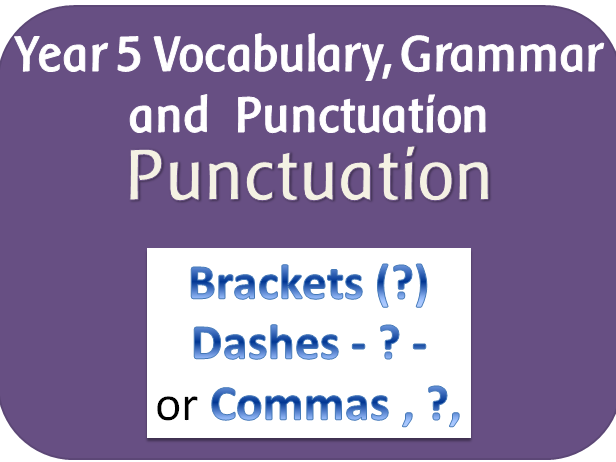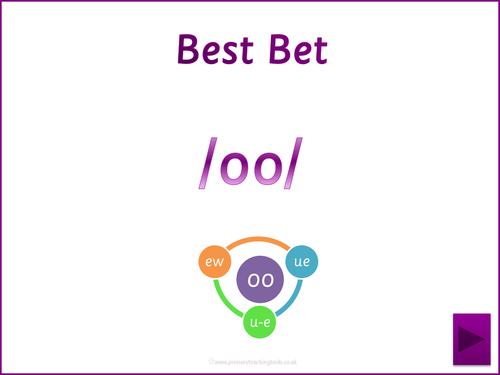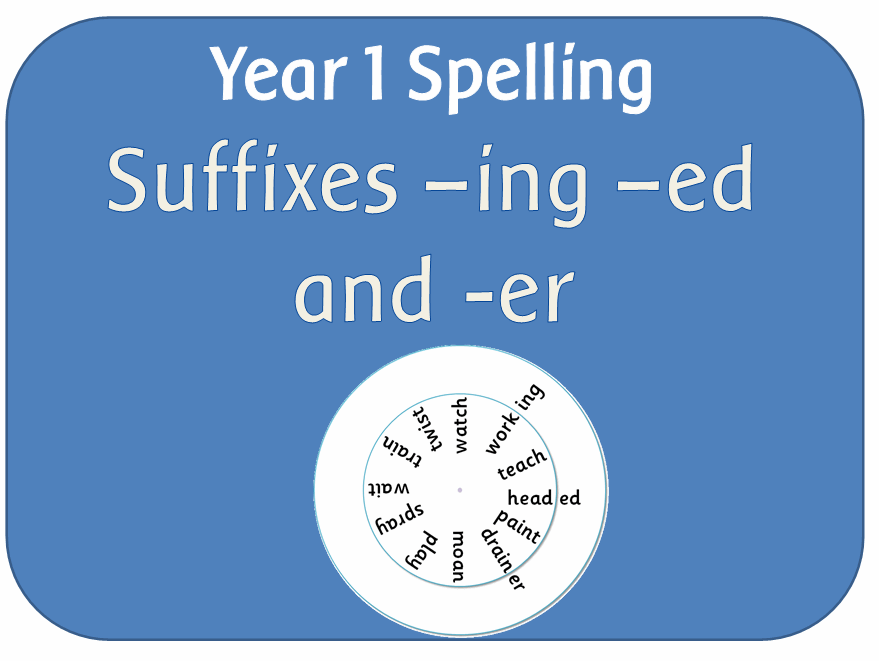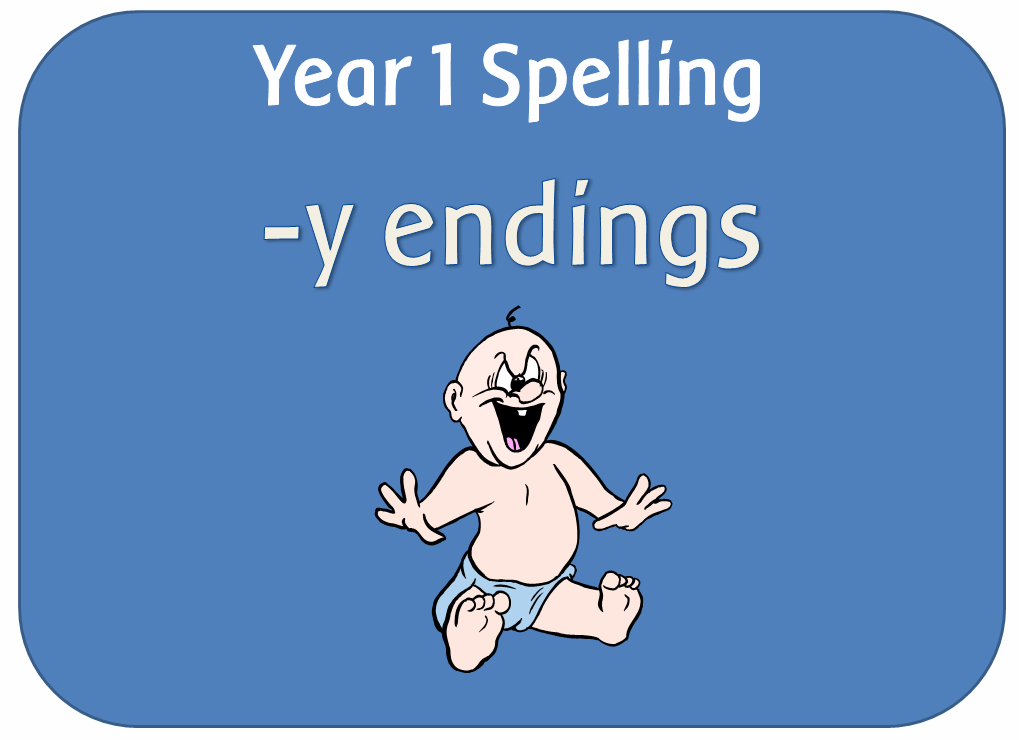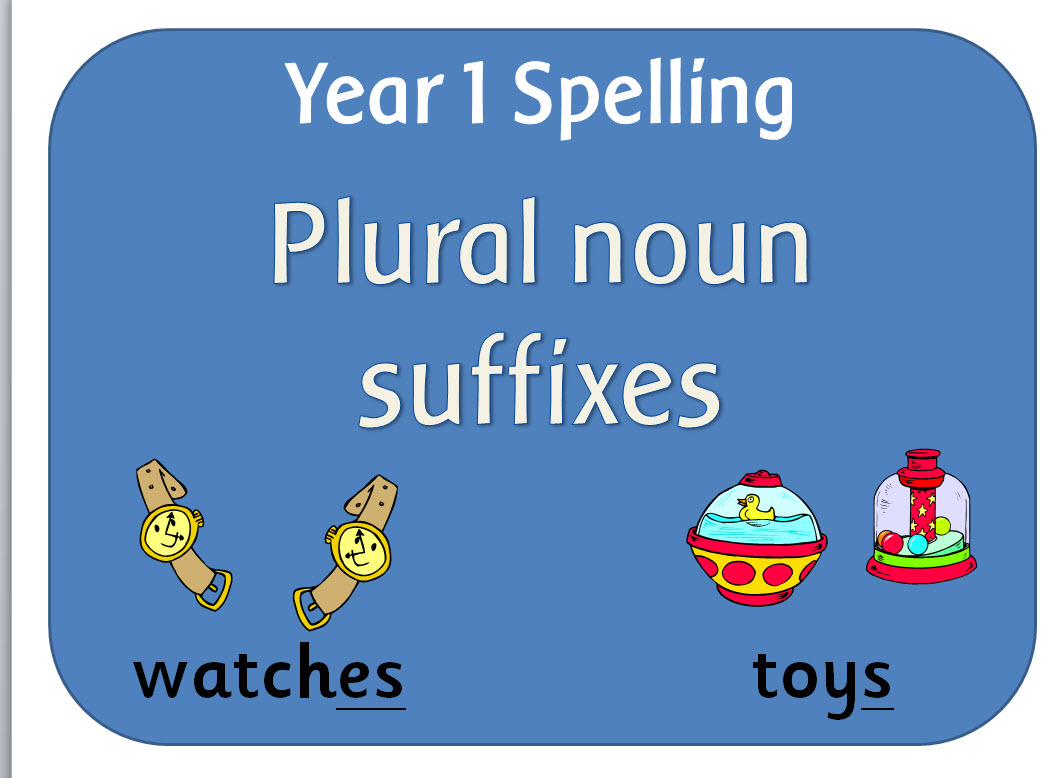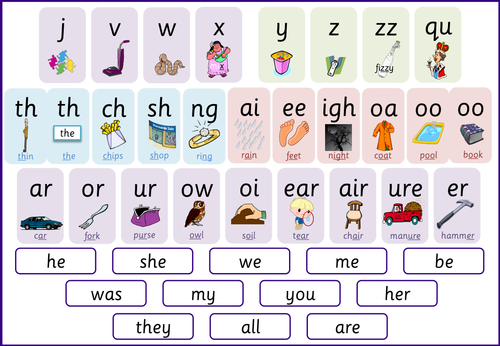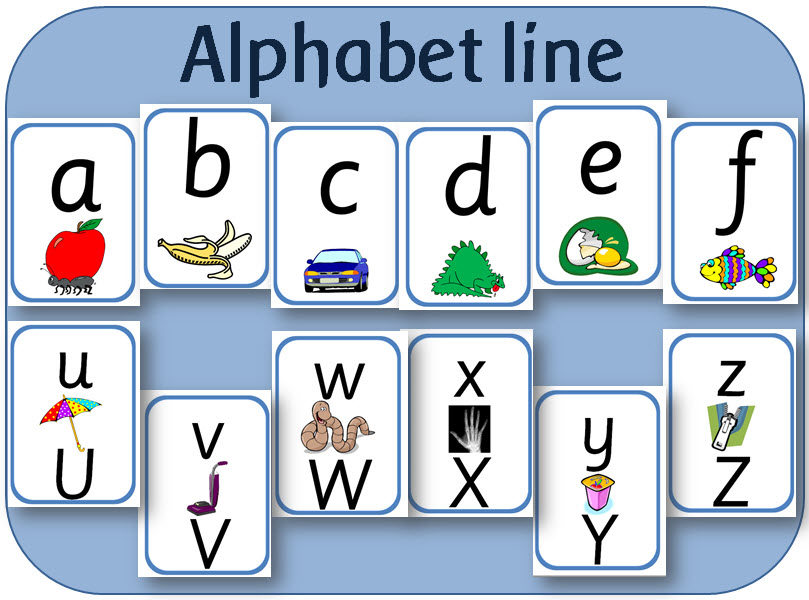
404Uploads
1072k+Views
683k+Downloads
English

SPaG Year 5 Punctuation: Parenthesis (brackets, dashes, commas) and commas to clarify meaning
This pack contains 2 powerpoint lessons:
Parenthesis: How brackets, dashes or commas can be used to indicate parenthesis.
Commas: Gives examples of what can happen if commas are omitted, and how they are important to the intended meaning.

Letters and Sounds Phase 5 Phonic pack: Alternative spellings of /igh/
There are a variety of different activities for each phoneme.
The descriptions of the powerpoints are as follows:
Word list powerpoint: Begins with a list of words for reading, then shows each word individually for writing.
Best Bet powerpoint: Introduces the different graphemes for each phoneme, then shows a picture and part of a word, with the relevant grapheme hidden. The children have to choose which grapheme is missing. Each word is added to a table that can be analysed at the end of the game.
Homophones with pictures powerpoint: Contains identical sounding words relating to the phoneme, showing the different spellings and pictures to help remember which is which.
Homophones: Contains identical sounding words relating to the phoneme, with no pictures.
Phoneme Spotter Stories - Three versions of each story - PowerPoint, Smartboard, and pdf format.
Rhyming word generation Smartboard file for recording words with different graphemes.

Letters and Sounds Phase 5 Phonic pack: Alternative spellings of long /oo/
There are a variety of different activities for each phoneme.
The descriptions of the powerpoints are as follows:
Word list powerpoint: Begins with a list of words for reading, then shows each word individually for writing.
Best Bet powerpoint: Introduces the different graphemes for each phoneme, then shows a picture and part of a word, with the relevant grapheme hidden. The children have to choose which grapheme is missing. Each word is added to a table that can be analysed at the end of the game.
Homophones with pictures powerpoint: Contains identical sounding words relating to the phoneme, showing the different spellings and pictures to help remember which is which.
Homophones: Contains identical sounding words relating to the phoneme, with no pictures.
Phoneme Spotter Stories - Three versions of each story - PowerPoint, Smartboard, and pdf format.
Rhyming word generation Smartboard file for recording words with different graphemes.

Suffix spelling rules posters KS1 & KS2
Seven posters explaining the different rules for adding suffixes covered in Appendix 1 of the English 2014 curriculum for years 2, 3 and 4, with a heading 'Suffix Spelling Rules'.

SPaG Year 1 Spelling pack: Adding the endings ing ed and er to verbs
A set of resources to teach the guideline/rule in the Spelling Appendix:
Adding the endings ing ed and er to verbs where no change is needed to the root word
POWERPOINTS:
Adding ing: Explains what a verb is and how ing can be added to verbs where no change in spelling is needed. Ends with an activity
Adding ed: Explains what a verb is and how adding ed changes the tense of the verb to the past tense. It ends with an activity
Adding er: Explains the effect of adding er to a verb and gives examples. Ends with an activity for the children to add er to verbs.
PDF:
Adding suffixes er ing ed: A list of words in a grid to add suffixes to.
Word wheel - Adding ed and ing: Verbs and suffixes for word building activities.
Word wheel - Adding ed, ing and er: Verbs and suffixes for word building activities.
WORD:
Outline adaptable plan

SPaG Year 1 Spelling pack: Words ending in y
A set of resources to teach the guideline/rule in the Spelling Appendix:
When a word ends in an /i:/(‘ee’) or /ɪ/ (‘i’) sound, it can be spelt –y.
POWERPOINT: Explains the spelling rule and gives examples of words for a class activity where the children can try to spell the words.

Phonics flashcards
A set of phonics display/flashcards to use in KS1.
There are 2 A5 cards on a page. Each card contains pictures and a list of words including the relevant common exception words for Year 1.
The first set contains the letters of the alphabet.
The second set contains the consonant digraphs and vowel digraphs and trigraphs in the Y1 Spelling appendix.
The third set contains extra graphemes identified in the Letters and Sounds phonics programme.

SPaG Year 1 Spelling: Adding s and es to words (plural of nouns and third person singular of verbs)
A set of resources to teach the guideline/rule in the Spelling Appendix: If the ending sounds like /s/ or /z/, it is spelt as –s. If the ending sounds like /ɪz/ and forms an extra syllable or ‘beat’ in the word, it is spelt as –es.
4 POWERPOINTS:
Introduction to regular plural noun suffixes: Explains what singular and plural is, and when to add s or es to nouns.
Regular suffix s and es sentences: Gives the spelling rule, if the ending sounds like /s/ or /z/, it is spelt as s. If the ending sounds like /ɪz/ and forms an extra syllable or ‘beat’ in the word, it is spelt as es. It gives examples of different types of words with these endings and ends with sentences for children to think of the missing plural word.
s or es quiz: Interactive quiz where the children have to choose between adding s or es.
ACTIVITIES:
Adding s or es worksheet: A list of words to make plural.
Show me cards - s or es
WORD:
Outline adaptable plan
List of words with plurals and verbs ending -es

SPaG Year 1 Terminology powerpoint
Explanations of the terminology letter, capital letter, words, singular, plural, sentence, punctuation, full stop, question mark and exclamation mark.

SPaG Year 2 Spelling: Homophones and near homophones
Resources to teach a variety of homophones and near homophones
POWERPOINT
Introduction to homophones: Explains why the English language has so many homophones
Year 2 Homophones with pictures: Includes be/bee, been/been, bare/bear, blew/blue, for/four, here/hear, knew/new, night/knight, know/no, one/won, pair/pear, plain/plane, quite/quiet, red/read, right/write, sea/see, where/wear, so/sew/saw, some/sum, son/sun, tail/tale, their/they're/there, through/threw, to/too/two, week/weak and which/witch
Writing sentences with homophones: Activity for sentence writing
The following powerpoints look at individual pairs/trios of homophones, explaining the differences, and giving sentences at the end to choose which one is the correct word:
Homophones they're their there
Homophones hear and here
Homophones son and sun
Homophones to two and too
Homophones be and bee
ACTIVITIES
Homophone cards with pictures
Homophone cards (just words)
TEACHER RESOURCES
Y2 Spelling Appendix: An adaptable outline plan
Word List - With relevant words

SPaG Year 2 Word: -er and -est in adjectives and -ly to turn adjectives into adverbs
2 powerpoint lessons and a worksheet:
THE USE OF LY TO TURN ADJECTIVES INTO ADVERBS
POWERPOINT
Using ly to turn adjectives into adverbs: Explains what adverbs are and how to make them by adding ly to adjectives.Gives a list of words to add ly to.
ACTIVITY
Making adverbs worksheet: Writing sentences with adverbs
USING THE SUFFIXES ER AND EST IN ADJECTIVES
POWERPOINT
Suffixes er and est as comparatives: Explains how they change the meaning of words. Gives a list of words to add the suffixes to and think of sentences with them in.

SPaG Year 5 & 6 Spelling: Use of the hyphen
A powerpoint lesson and a jigsaw activity to teach the spelling guidelines:
Hyphens can be used to join a prefix to a root word, especially if the prefix ends in a vowel letter and the root word also begins with one.

SPaG Year 5 Word Grammar: Verb prefixes
A set of powerpoints and activities to teach verb prefixes such as dis-, de-, mis-, over- and re-, with a recap of previously learnt prefixes.
POWERPOINTS:
Prefixes un- dis- and mis-: Looks at the 3 prefixes; how they change the meanings of words; and words they can be added to.
Changing words into negatives with prefixes: un, de, anti, dis and il
Prefix meanings: 9 prefixes and their meanings
Prefixes dis, de, mis, over, re and pre: Looks at each prefix and words containing them individually, so one can be taught per session.
PRINTABLE FILES (PDF):
Prefix list and meanings
Prefix word list dis de mis over & re (word file)
Wordsearch x 6 (un-, dis-, de-, mis-, pre- and re-)
Change the paragraph to the opposite meaning using prefixes worksheet
Definitions worksheets x 4
Definitions matching cards
Extension work - more prefixes x 3 worksheets
Negatives

Letters and Sounds Phase 3 word / help mats
The picture grapheme and word mat:
This word mat is to aid in the teaching and learning of sounds and tricky words in phase 3. Each letter is accompanied by a relevant picture, to give children visual cues to help them learn each grapheme. Each group is represented in a different colour, so that it is easy to focus on the letter sounds being learnt. Also on the word mat are the 12 tricky words from phase 3 for the children to learn.
Grapheme and word mat:
The second word mat is similar to the first, but with the visual cues removed, to help those children who know which letters represent which sounds, but still need prompts to recognise the written letters.
Phase 3 word mat - contains visual cues for Jolly Phonics.

Letters and Sounds Phase 4: Reading and writing CVCC words
A variety of interactive and printable activities for reading and writing words ending with adjacent consonants.
Includes:
In the box games
Matching words and pictures games
Buried treasure game
Writing activities
Phoneme frames

KS1 Fantasy stories - story maker settings, characters and objects
An introduction to fantasy stories - one powerpoint looks at the difference between fact and fiction; the second powerpoint guides the children through making up their own fantasy stories.
The printable files are cards - each set has 12 images so the children can use them to choose a setting, main character and an object.

Alphabet line / frieze for display with lower and upper case letters
This set contains 26 alphabet flashcards in lower case and 26 in upper and lower case, both in Sassoon Primary font, with pictures matching each initial letter sound.
There are also alternate lower case letters for f and k, plus ck, ll, ff, ss and zz.
There are 2 cards per A4 page for you to print as many times as you like.
They can be used as flashcards, for an alphabet frieze or other display work.

SPaG Year 1 Spelling pack: Vowel digraphs and trigraphs set 3
This pack contains the last 11 digraphs/trigraphs in the spelling appendix.
POWERPOINTS:
All presentations are superhero-themed and contain a quiz with words containing the relevant grapheme. They can be used for both reading and spelling activities.
25. ie (i)
26. ie (aɪ)
27. igh
28. or
29. ore
30. aw
31. au
32. air
33. ear
34. ear (ɛə)
35. are

SPaG Year 4 Word Grammar: Standard English forms for verb inflections
A powerpoint looking at how suffixes change the way verbs work, with some examples of standard English to use in writing rather than local spoken forms, plus a list of irregular verbs.

SPaG Year 2 Spelling: A recap of the rules for adding suffixes
A powerpoint looking at the rules learnt so far for adding suffixes beginning with vowel letters.

